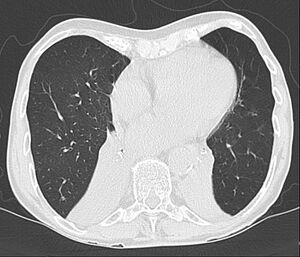Atelectasis
Atelectasis is the lack of air in the lung tissue.
Lung collapse and atelectasis express the same condition, ie "airlessness" of the lung tissue. CAVE !!! The term atelectasis is reserved for newborns (their lungs have never been developed). The collapse is reserved for secondary lung airtightness (the lungs have already developed, but have secondaryly become airtight).
The lungs did not develop at all = atelectasis - in newborns for various reasons (atelectasis neonatorum):
- immature infants who have insufficient surfactant production;
- ventilation disorders due to CNS damage or chest deformities;
- massive amniotic fluid aspiration in complicated childbirth.
The lungs were developed but collapsed = collapse.
Causes of lung collapse[edit | edit source]
- Obstructive collapse - stenosis to obstruction of the bronchi with subsequent resorption of air present during obstruction - body aspiration, tumor, accumulated secretion, blood coagulum, external compression - lymph node, aneurysm
- Compression collapse - expulsion of air from lung tissue in connection with pathological contents in the pleural cavity (fluid, blood, air) - oppression of the lungs, especially at the base; pneumothorax.
Consequences[edit | edit source]
With the early elimination of the cause, the collapsed lungs will re-develop, but with prolonged airiness, the respiratory surface will be lost - so-called splenization (the lung tissue is red-purple with a consistency similar to the spleen), it is an irreversible condition.
- increased susceptibility to infections - dystelectric pneumonia;
- sometimes secondary bronchiectasis occurs.
Links[edit | edit source]
Related articles[edit | edit source]
References[edit | edit source]
- POVÝŠIL, Ctibor. Speciální patologie. 2. edition. Praha : Galén, 2007. vol. 430. ISBN 978-807262-494-2.

